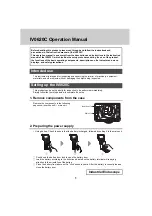
1 System
Description
Part 1 of this manual provides background information on the system, including
descriptions of the principal components and overviews of how the system functions. It
is divided into the following sections:
•
•
1.2: Operator’s Manual Overview
•
•
•
•
•
1.7: Introduction to SOFTmax PRO Application Software
1.1 Introduction
FlexStation™ II Systems provide integrated fluid transfer capability from a source plate
or reservoir to an assay plate with concurrent kinetic fluorometric analysis of reactions.
Data collection speed is sufficient for running fast cell-based kinetic assays. The
instruments feature a bottom-read mode ideal for whole-cell-based assays, and may be
automatically switched to a top-read mode for solution-phase reactions.
FlexStation II Systems can be used for drug discovery research and development,
secondary and post screen analysis. The instruments are available in two models:
•
The FlexStation™ II instrument is designed specifically for 96-well microplates.
•
The FlexStation™ II
³⁸⁴
instrument is designed for 96- and 384-well microplates.
The instruments offer 96- and 384-well microplate-to-microplate fluid transfer (8 or 16
wells at a time), and can read microplates having 6, 12, 24, 48, 96, and 384-well
formats. Top or bottom detection is available with a simple click of a button.
A microplate adapter is required in the reading chamber drawer for 96- and 384-well
assay plates, for both bottom and top reading. The black adapter allows for optimal
signal for bottom readings, and the purple adapter optimizes top-read scenarios. A
different baseplate is provided for the compound plate drawer.
The instrument is controlled by an external personal computer running the SOFTmax®
PRO software, which provides integrated instrument control, data display, and statistical
data analysis.
The system can perform a variety of fluorescence applications, as well as some limited
time-resolved fluorescence and luminescence operations. The system’s extreme flexibility
and high sensitivity make it appropriate for applications in biochemistry, cell biology,
immunology, molecular biology, and microbiology. The instrument uses two
holographic diffraction grating monochromators that allow for individual optimization
of both excitation and emission wavelengths. The dual-scanning capability can also be
used to determine excitation and emission settings for new fluorescent probes. Mirrored
FlexStation II Operator’s Manual – Rev. D
1
Содержание FlexStation II
Страница 6: ...FlexStation II Operator s Manual Rev D vi ...
Страница 92: ...4 Applications 86 FlexStation II Operator s Manual Rev D ...
Страница 102: ...5 Service and Maintenance Procedures 96 FlexStation II Operator s Manual Rev D ...
Страница 124: ...6 Troubleshooting Procedures 118 FlexStation II Operator s Manual Rev D ...
Страница 134: ...7 Appendices 128 FlexStation II Operator s Manual Rev D ...








































